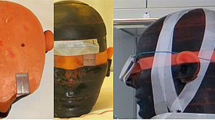Abstract
Purpose
The annual permissible radiation ocular lens dose has been reduced to 20 millisieverts (mSv) in the current European directive 2013/59/Euratom. The aim of this study was to evaluate the personal radiation dose for vascular interventions with special focus on ocular lens dose.
Materials and Methods
From May 2016 to October 2016, the personal radiation doses of two interventionists and four technicians were prospectively recorded during 206 vascular interventions. The position of personnel, intervention type and fluoroscopy time were recorded. Parameters evaluated were total body dose measured by film dosimeter, hand dose measured by ring thermoluminescent dosimeter (TLD) and ocular lens dose measured by TLD placed in front of the safety glasses. Linear regression analysis was used to estimate the dose at 2 and 5 years.
Results
The ocular lens dose, hand and total body dose of the two interventionists were 11/5, 56/47 and 0.6 mSv each, respectively. The estimated 5-year ocular dose was 113.08 mSv (95% CI 38.2–187.97)/40.95 (95% CI 16.9–64.7). Similarly, hand dose was 608.4 mSv (95% CI 442.78–774.38)/514.47 (95% CI 329.83–699.10) and body dose 6.07 mSv (95% CI 4.70–8.22)/5.12 (95% CI 3.65–6.59), respectively. Amongst four technicians, only the first assistant showed recordings of 0.3 mSv body dose, 2 mSv ocular lens dose and 5 mSv hand dose.
Conclusion
The yearly ocular lens dose, particularly for interventionists dealing with complex interventions, could cross the permitted yearly limit set by the new Euratom directive. Therefore, X-ray safety glasses would become mandatory for complex radiological vascular interventions.
Level of Evidence
Level III, non-randomized controlled cohort/follow-up study.



Similar content being viewed by others
References
King JN, Champlin AM, Kelsey CA, et al. Using a sterile disposable protective surgical drape for reduction of radiation exposure to interventionists. Am J Roentgenol. 2002;178:153–7.
Hausler U, Czarwinski R, Brix G. Radiation exposure of medical staff from interventional X-ray procedures: a multicentre study. Eur Radiol. 2009;19:2000–8.
Antic V, Ciraj-Bjelac O, Rehani M, et al. Eye lens dosimetry in interventional cardiology: results of staff dose measurements and link to patient dose levels. Radiat Prot Dosim. 2013;154:276–84.
Vano E, Gonzales L, Beneyetz F, et al. Lens injuries induced by occupational exposure in non-optimised interventional radiology laboratories. Br J Radiol. 1998;71:728–33.
Vano E, Kleiman NJ, Duran A, et al. Radiation cataract risk in interventional cardiology personnel. Radiat Res. 2010;174:490–5.
Ciraj-Bjelac O, Rehani MM, Sim KH, et al. Risk for radiation induced cataract for staff in interventional cardiology: Is there reason for concern? Catheter Cardiovasc Interv. 2010;76:826–34.
European Council Directive. European Council Directive 2013/59/Euratom on basic safety standards for protection against the dangers arising from exposure to ionising radiation and repealing Directives 89/618/Euratom, 90/641/Euratom, 96/29/Euratom, 97/43/Euratom and 2003/122/Euratom. Off J Eur Union L13. 2014;57:1–73. http://data.europa.eu/eli/dir/2013/59/oj.
European Society of Radiology (ESR). Summary of the European Directive 2013/59/Euratom: essentials for health professionals in radiology. Insights Imaging. 2015;6(4):411–7. https://doi.org/10.1007/s13244-015-0410-4.
Szumska A, Kopec R, Budzanowski M. Occupational doses of medical staff and their relation to patient exposure incurred in coronary angiography and intervention. Radiat Meas. 2016;84:34–60.
De Angelis LM. Brain tumors. N Engl J Med. 2001;344:114–23.
Roguin A, Goldstein J, Bar O. Brain tumours among interventional cardiologists: A cause for alarm? Report of four new cases from two cities and a review of literature. EuroIntervention. 2012;7:1081–6.
Roguin A. Brain tumours among interventional cardiologists: A call for alarm? Eur Heart J. 2012;33:1850–1.
Brown NP. The lens is more sensitive to radiation than we believed. Br J Ophthalmol. 1997;81:257.
Kleimann NJ. Radiation cataract. Ann ICRP. 2012;41:80–97.
Nakashima K, Neriishi K, Minamoto A. A reanalysis of atomic bomb cataract data, 2000–2002: a threshold analysis. Health Phys. 2006;90:154–60.
Neriishi K, Nakashima E, Minamoto A, et al. Postoperative cataract cases among atomic bomb survivors: radiation dose response and threshold. Radiat Res. 2007;168:404–8.
Authors on behalf of ICRP, Stewart FA, Akleyev AV, Hauer-Jensen M, et al. ICRP publication 118: ICRP statement on tissue reactions/early and late effects of radiation in normal tissues and organs: threshold doses for tissue reactions in a radiation protection context. Ann ICRP. 2012;41:1–322.
ICRP. ICRP Publication 103: The 2007 recommendations of the international commission on radiological protection. Ann ICRP. 2007;37(2–4):1–332.
Domienik J, Brodecki M, Rusicka D. A study of dose distribution in the regions of the eye lens and extremities for staff working in interventional cardiology. Radiat Meas. 2012;47:130–8.
Carinou E, Ginjaume M, Connor O, et al. Status of eye lens radiation dose monitoring in European hospitals. J Radiol Prot. 2014;34:729–39.
Szumska A, Budzanowski M, Kopec R. Occupational exposure to the whole body, extremities and to the eye lens in interventional radiology in Poland, as based on personal dosimetry records at IFJ PAN. Radiat Phys Chem. 2014;104:72–5.
Thornton RH, Dauer LT, Altamirano JP, et al. Comparing strategies for operator eye protection in the interventional radiology suite. J Vasc Interv Radiol. 2010;21:1703–7.
Koukorava C, Farah J, Struelens L, et al. Efficiency of radiation protection equipment in interventional radiology: a systematic Monte Carlo study of eye lens and whole body doses. J Radiol Prot. 2014;34:504–28.
Karadag B, Ikitimur B, Durmaz E, et al. Effectiveness of a lead cap in radiation protection of the head in the cardiac catheterisation laboratory. EuroIntervention. 2013;9:754–6.
Christopoulos G, Makke L, Christakapoulos G, et al. Optimizing Radiation safety in the cardiac catheterization laboratory: a practical approach. Catheter Cardiovas Interv. 2016;87:291–301.
Shoustary A, Islamian JP, Asadinezhad M, et al. An evaluation of the organ dose received by cardiologists arising from angiography examinations in educational hospital in Rasht. Glob J Health Sci. 2016;7:185–94.
Author information
Authors and Affiliations
Corresponding author
Ethics declarations
Conflict of interest
On behalf of all authors, the corresponding author states that there is no conflict of interest.
Rights and permissions
About this article
Cite this article
Thomas, R.P., Grau, M., Eldergash, O. et al. Will X-ray Safety Glasses Become Mandatory for Radiological Vascular Interventions?. Cardiovasc Intervent Radiol 41, 1074–1080 (2018). https://doi.org/10.1007/s00270-018-1960-x
Received:
Accepted:
Published:
Issue Date:
DOI: https://doi.org/10.1007/s00270-018-1960-x




